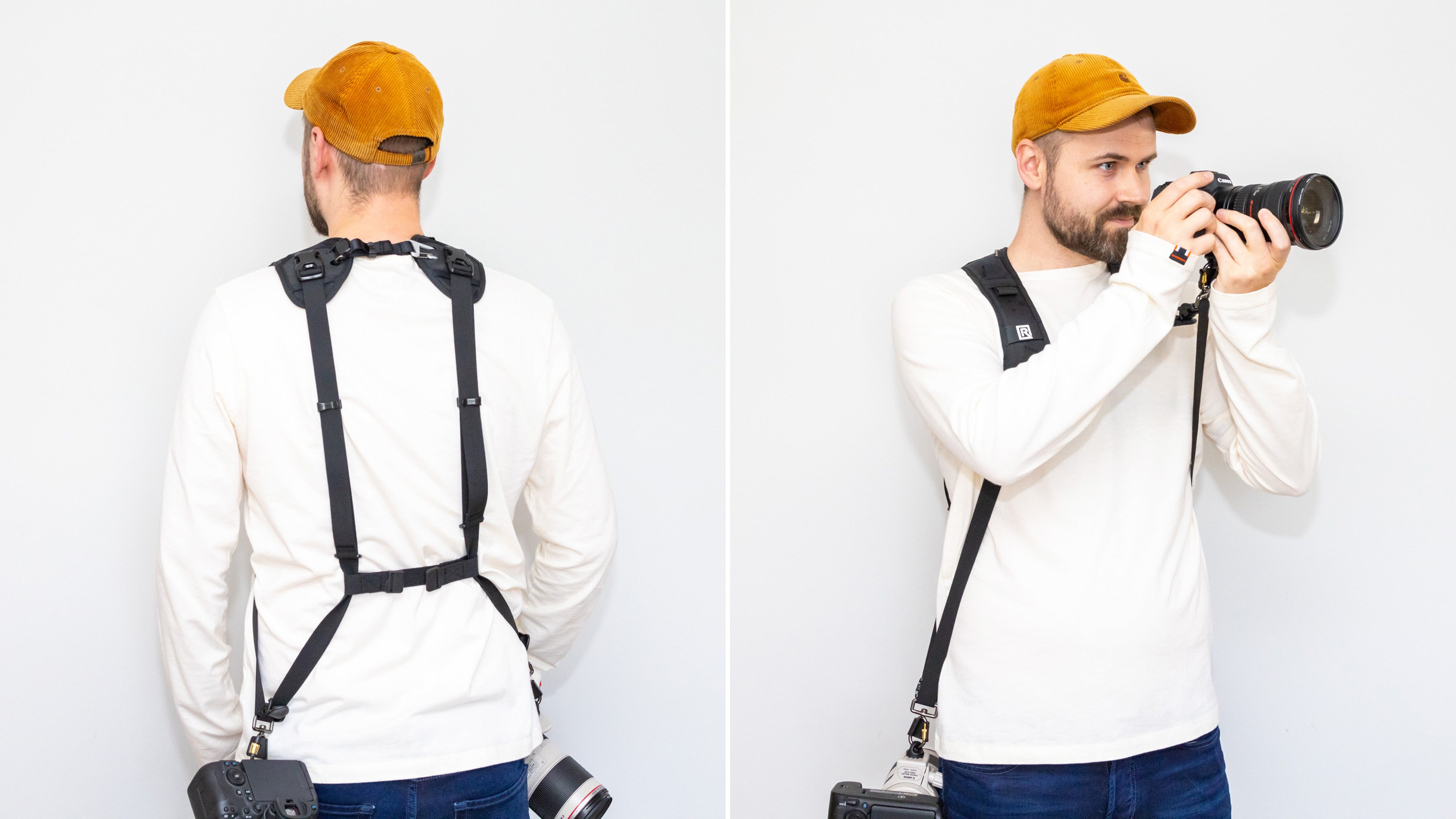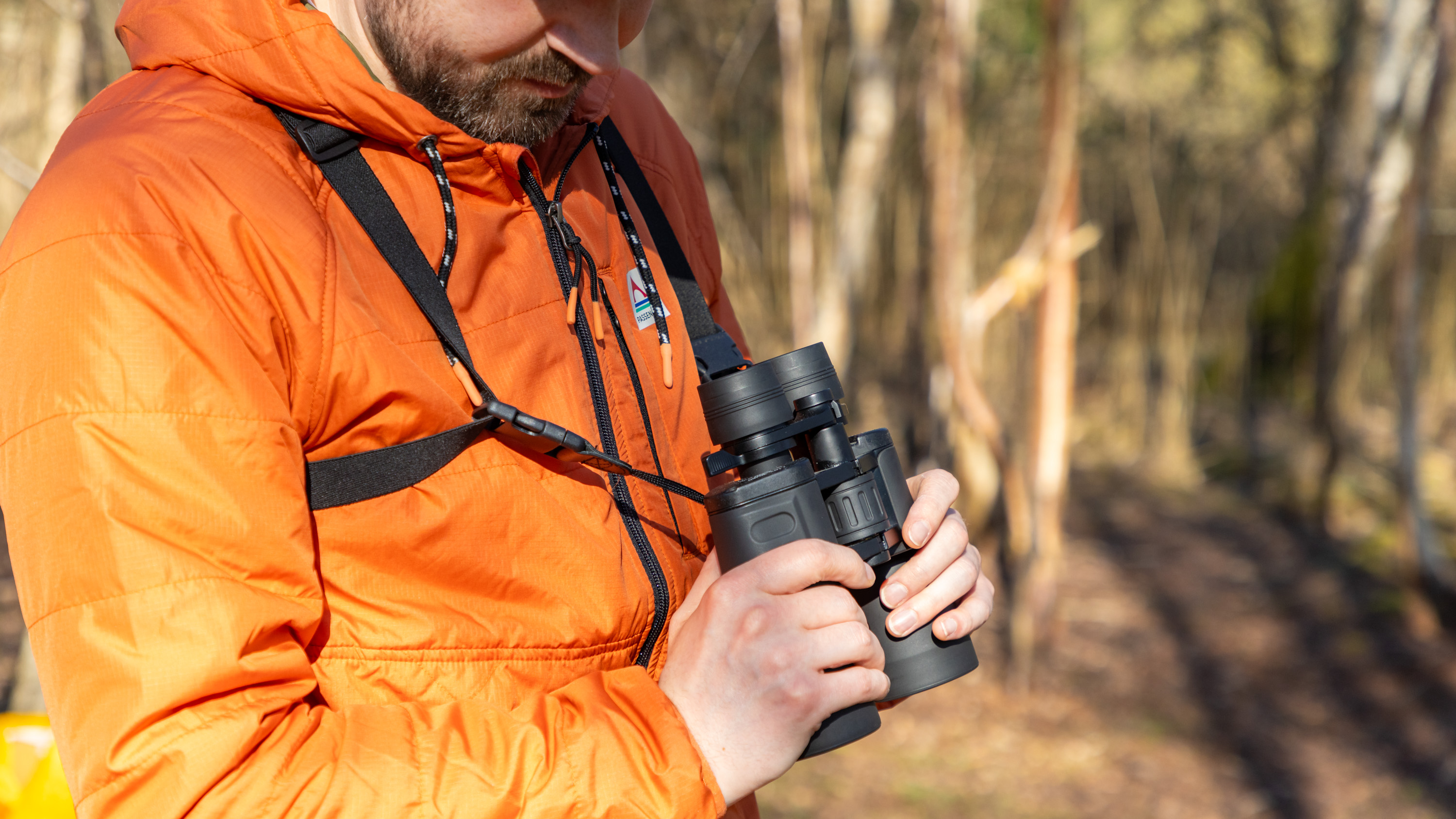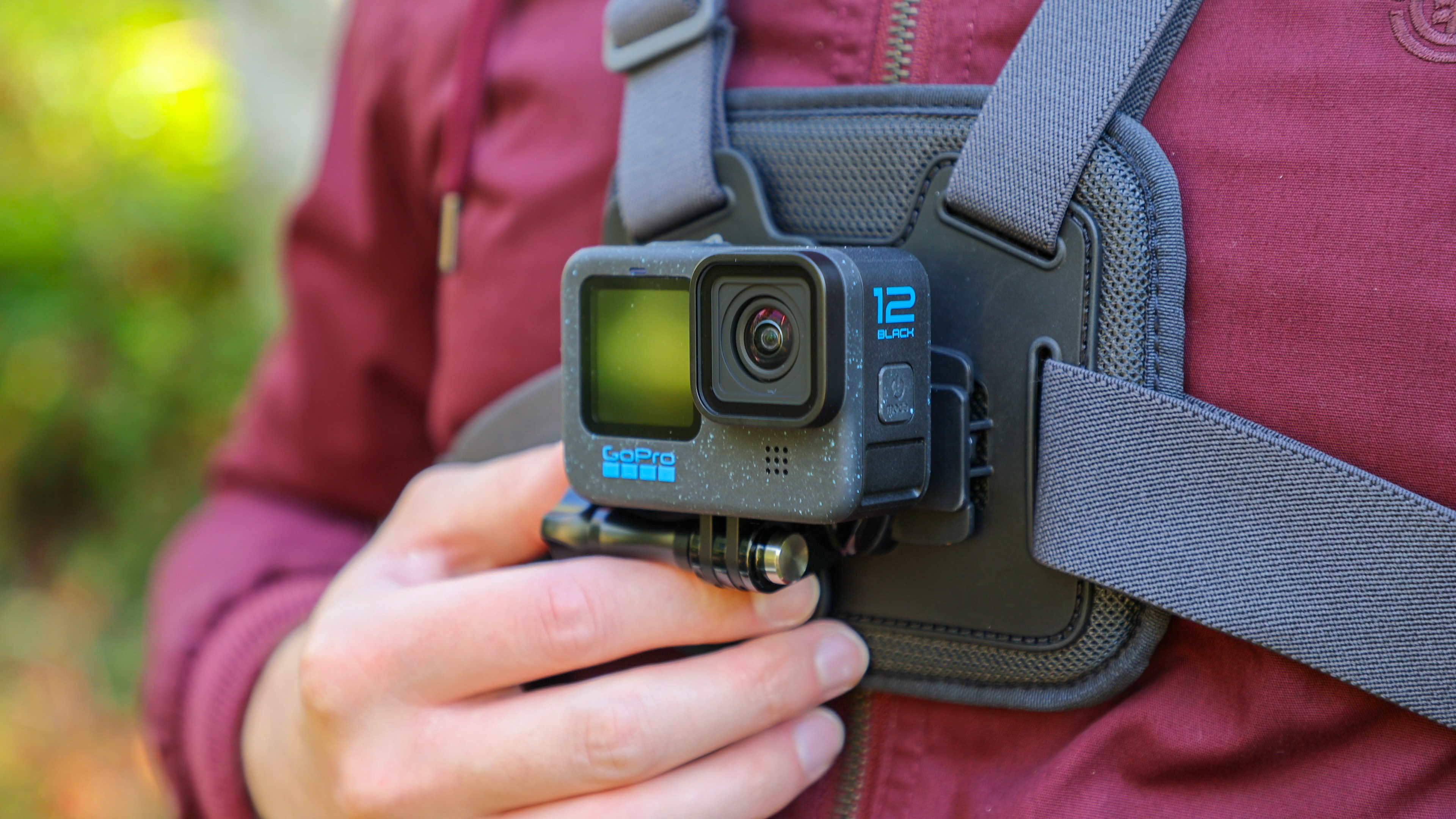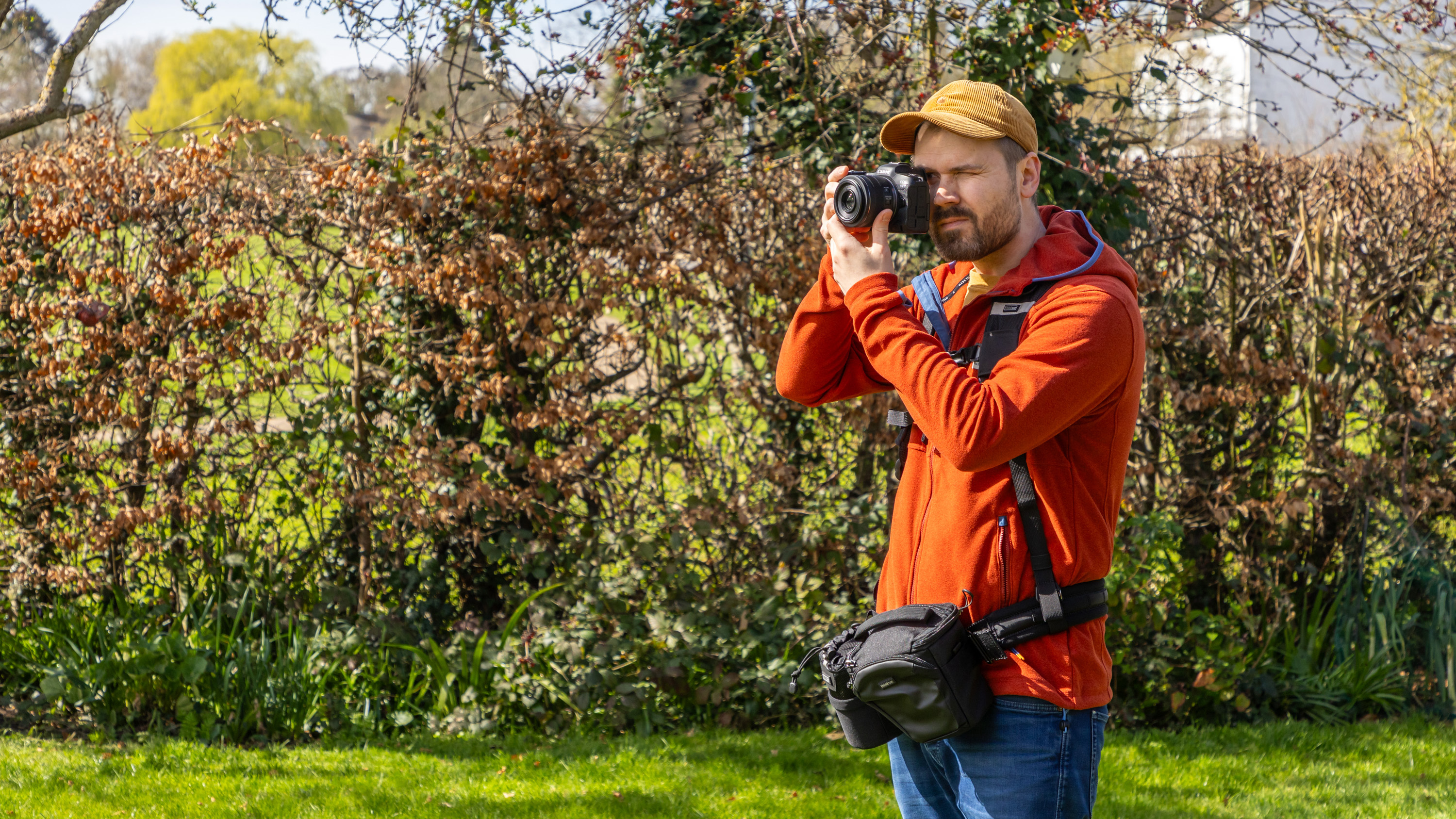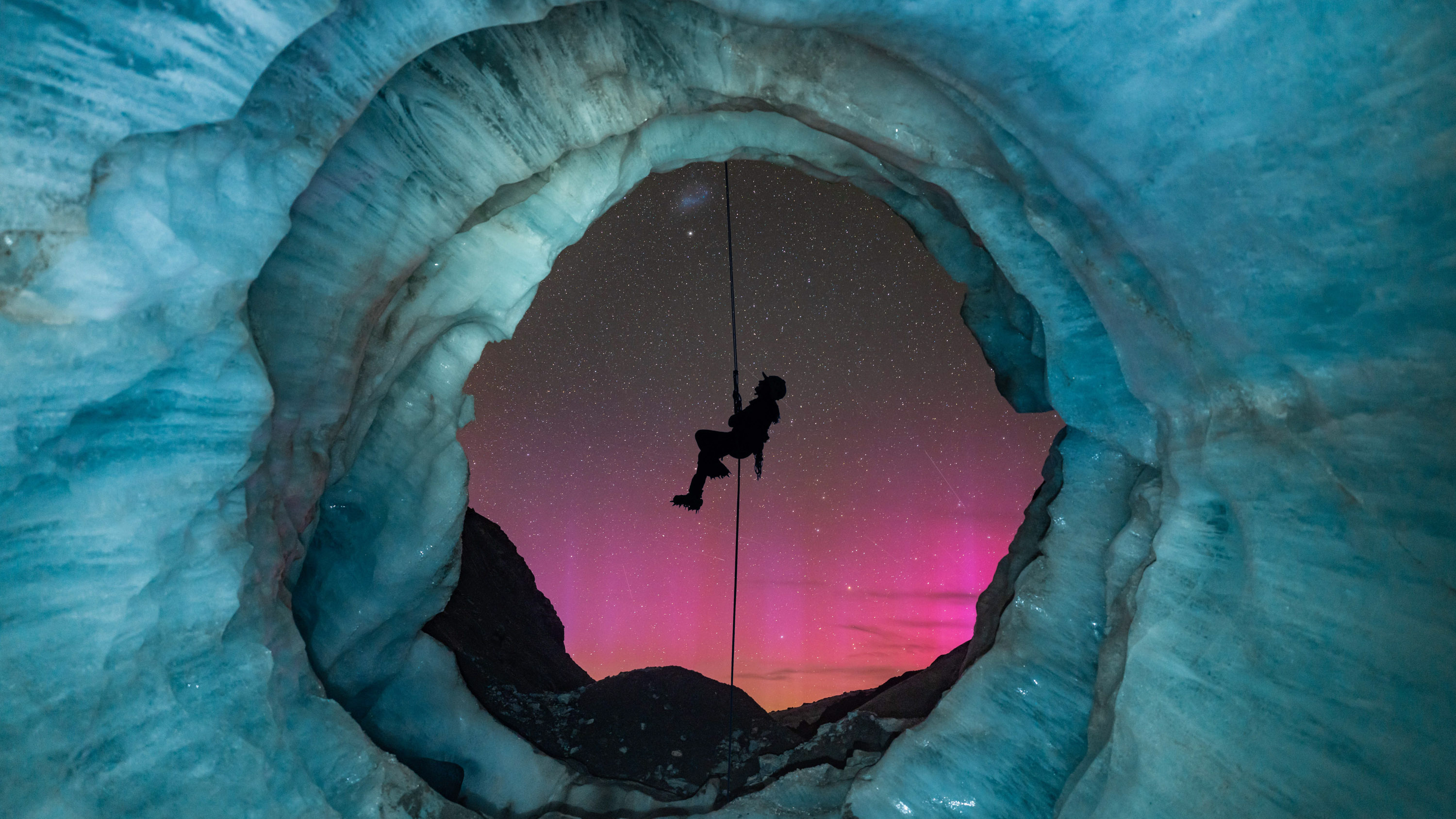The best camera harness in 2025: carry your cameras hands-free and in comfort
Protect your neck, back and shoulders from strain and pain with the best camera harnesses for outdoor photography shoots

The best camera harnesses give you quick and easy access to up to two cameras simultaneously. Styled like a set of braces, a jacket, or a belt, they transfer the weight of your camera bodies to your own body, helping you avoid a sore neck or back after a lengthy shoot.
Because let's be real: cameras are heavy. Whether we're talking chunky DSLRs or their more svelte mirrorless counterparts, a camera and lens combo adds up to be a considerable weight to hang from your neck if you rely only on the strap that came in the box, especially when it comes to long telephoto zooms.
So, while it's good to invest in the best camera bags, backpacks, holsters, and alternative straps, if you really want to evenly distribute the weight and maximize what you can carry, only a camera harness will do. There’s a harness for every conceivable set-up, but it's important to choose wisely. I've hand-picked a variety of camera harnesses to help you find the perfect way to take the weight off and go hands-free.

Dan is an intrepid photographer who loves shooting the great outdoors but hates having a cumbersome camera bouncing around his neck. He's personally tried and tested all the harnesses in this guide.
The Quick List

This lightweight option is super comfy, with padded shoulders for all-day shooting, and holds a couple of cameras dangling by the side.
Read more below

For small cameras or for binoculars, this classy option from Zeiss provides great build quality and a handy quick-release mechanism. It's also nicely compact.
Read more below
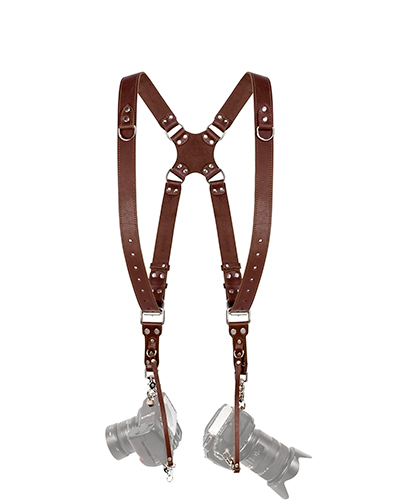
This high-quality leather harness offers an elegant solution for formal situations, enveloping the shoulders for a more comfortable fit than cheaper options.
Read more below
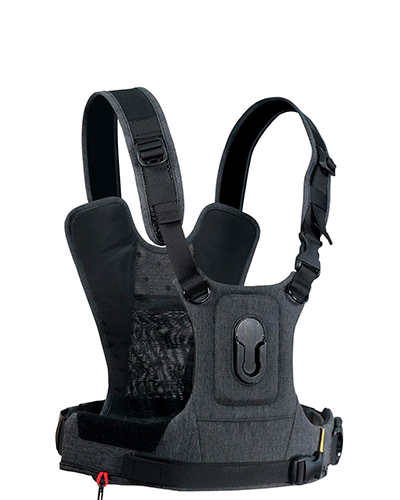
Combining a chest mount and optional side holster, the G3 securely carries up to two cameras. I love the quality of the materials and the amount of padding and support.
Read more below
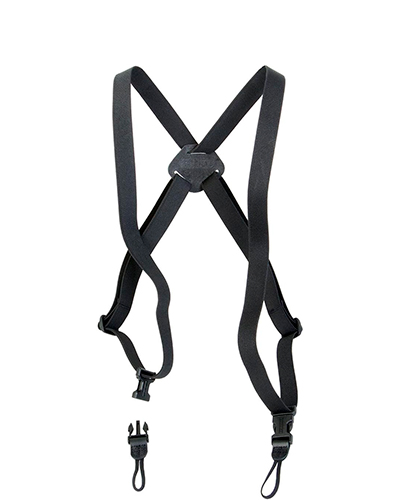
This basic, cheap harness isn't up to the job for a heavy setup, but it's a discreet and affordable option for compacts or mirrorless cameras with small lenses.
Read more below
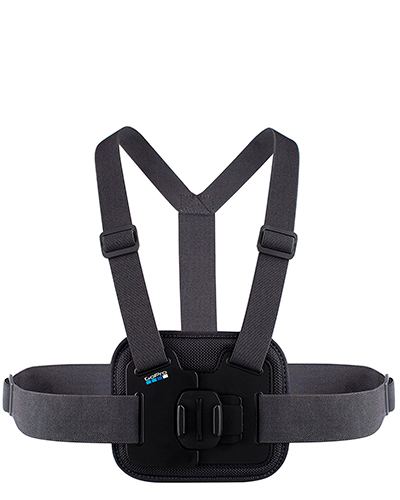
Lightweight and flexible, GoPro's own Chesty is perfect for chest-mounting a Hero or Max action camera, leaving your hands free for those action pursuits.
Read more below
Load the next products...

You'll need an additional belt and pouches for this modular system, but you can customize it to the gear you need for each shoot.
Read more below
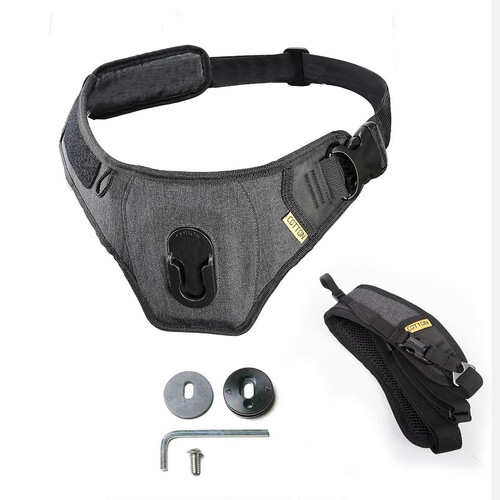
Let your hips take the strain with this belt-based system that comfortably places your camera on one hip and a spare lens on the other.
Read more below

For carrying a single body, the Skout 2 has a sling design and clamps your camera securely to your chest, but it can be removed in a jiffy when you're ready to shoot.
Read more below
The best camera harnesses
Why you can trust Digital Camera World
The best camera harness overall
Specifications
Reasons to buy
Reasons to avoid
My first impression of the BlackRapid Double Breathe Harness was one of robust, no-nonsense functionality. The "Breathe" shoulder pads are a significant feature; they're well-padded and designed for ventilation. Setting it up and adjusting it for a perfect fit was straightforward, and the whole system felt incredibly secure from the get-go, especially with the included safety tethers and locking carabiners.
In action, the Double Breathe performed brilliantly. The cameras glided smoothly up the straps when I needed them, allowing for that signature BlackRapid quick-draw access. The bumpers on the straps were great for keeping the cameras from swinging too far back or forward when I was moving around. Even with two pro-sized DSLRs, the weight distribution was excellent, and I experienced significantly less fatigue compared to other systems I've used. The included accessory pouch was a nice touch for small essentials, too.
It might not have the classic aesthetic appeal of some leather harnesses I’ve seen, but, for me, function and reliability trump style. This harness is built for performance. It kept my valuable gear secure, allowed me to be agile, and honestly, I often forgot I was wearing it, which is probably the best compliment I can give. For any photographer who needs to carry two cameras comfortably and securely for extended periods, the BlackRapid Double Breathe Harness is a top-tier solution and a very worthwhile investment.
See our full BlackRapid Double Breathe review
The best camera harness for small cameras
Specifications
Reasons to buy
Reasons to avoid
As someone who spends a lot of time shooting outdoors, often for hours on end, I've learned that a comfortable carrying system isn't a luxury – it's a necessity. I’ve tried plenty of camera straps and harnesses, but the Zeiss Comfort Carry Harness promises superior comfort, albeit at a premium price tag. It's certainly a step up in quality. The materials feel robust yet refined, and design details like the breathable backplate and the wide, supportive elastic straps immediately suggested a focus on ergonomics. Setting it up and adjusting it for a snug fit was straightforward.
I found the harness distributed the weight perfectly across my shoulders and back, virtually eliminating the neck strain I’d grown accustomed to; the camera sitting securely against my chest, without swinging around, yet instantly accessible when I needed it. The comfort was genuinely exceptional; I barely noticed I was carrying my gear, even after a full day. It allowed me to focus on spotting wildlife rather than on any discomfort.
While it’s primarily designed for binoculars, it easily supports a small camera setup. Yes, it's more expensive than many other harnesses on the market, but in my experience, the superior comfort, build quality, and thoughtful design make it a worthwhile investment. If you're serious about your outdoor pursuits and want to carry your optics in maximum comfort, I’d say the Zeiss Comfort Carry Harness is an excellent choice that truly lives up to its name.
Read our full Zeiss Comfort Carry Harness review
The best camera harness for wedding photographers
Specifications
Reasons to buy
Reasons to avoid
For event photographers, particularly those shooting weddings, juggling two camera bodies with different lenses is pretty much standard fare. They need quick access to both, without fumbling or risking a drop, while looking smart enough to merge in with the wedding party. The Coiro Dual Camera Harness has a reputation as a stylish yet budget-friendly option. It's made from genuine leather and is available in a few colours. Straight out of the box, the leather felt quite stiff, and the harness itself has a bit of weight to it.
Putting it through its paces on a wedding shoot, I found the ability to have both my cameras securely at my sides, ready to grab, was invaluable. Switching between wide-angle and telephoto setups was seamless, and I didn’t miss any critical moments. The cameras felt secure, and the harness did a decent job of distributing the weight across my shoulders, though the inherent weight and stiffness of the leather meant I was certainly aware I was wearing it by the end of the day. I also noticed a slight "jingling" sound from the metal hardware as I moved around.
While it might lack some of the refined features or lighter materials of high-end harnesses that cost significantly more, the Coiro harness delivers fantastic value. It offers genuine style and robust functionality for photographers needing a reliable two-camera solution without breaking the bank. If you’re looking for a durable, good-looking leather dual harness and are prepared for a bit of a break-in period for the leather, this is a brilliant budget-friendly choice that gets the job done effectively.
See our full Coiro Dual Camera Harness review
The best vest-style harness
Specifications
Reasons to buy
Reasons to avoid
The Cotton Carrier CCS G3 Harness is a robust piece of kit, made from durable materials such as Kodra canvas. The vest-style design promises better weight distribution than single straps, and adjusting it for a snug fit was straightforward, with the chest plate positioning the camera perfectly for quick access.
In the field, I found that the G3 harness really shone when on the move. With my DSLR and telephoto zoom mounted securely on my chest, thanks to the patented Twist & Lock system, the camera felt incredibly secure, with no bouncing around, leaving my hands completely free. Grabbing the camera for a quick shot was easy – a simple twist and it was ready. The weight distribution was generally good, and for most of my setups, it was very comfortable. The included rain cover and safety tether for added peace of mind are nice touches.
However, I did notice a couple of things. With my heaviest lens combination, I could still feel some strain, so it's not a complete cure-all for extremely weighty gear. I also experienced a little squeaking from the plastic-on-metal mounting system at times, and disengaging the Twist & Lock could be a little stiff with those heavier lenses attached. But, despite these minor points, I found the Cotton Carrier CCS G3 Harness offers excellent security and quick access, keeping your camera ready without being a burden.
See our full Cotton Carrier CCS G3 review
The best budget camera harness
Specifications
Reasons to buy
Reasons to avoid
The Op/Tech Bino-Cam Harness is primarily designed for binoculars, but is also suitable for lighter camera setups, such as a mirrorless with a kit lens attached. I opted for the elastic version, as I suspected it would offer a bit more give and comfort over the standard nylon webbing. Setting it up was straightforward, and the quick-release straps make it easy to attach and detach binoculars or cameras. Adjusting it to fit snugly, whether over a t-shirt or a thicker jacket, was also simple enough.
The harness distributes the weight evenly, significantly reducing neck strain, and I found that my gear felt secure and didn't bounce around as much as it does with a traditional strap. Having my binoculars or camera resting comfortably on my chest meant they were always ready for action, yet out of the way when I needed my hands free.
While the materials might not feel as luxurious as some more expensive harness systems, like those from Zeiss, this Op/Tech harness is undeniably functional and offers excellent value for its price. If you're looking for an affordable way to improve carrying comfort for your binoculars or a lighter camera setup without breaking the bank, this harness is worth considering.
See our full Op/Tech Bino-Cam Harness review
The best camera harness for action cameras
Specifications
Reasons to buy
Reasons to avoid
While helmet and handlebar mounts have their place for GoPros and similar action cams, the GoPro Chesty V2 harness enables a true first-person perspective. My first impression was how lightweight and breathable the Chesty is. The soft padding and adjustable elastic straps made it comfortable to wear, even for extended periods and over different layers of clothing, from a simple T-shirt to a bulkier jacket. Getting it fitted properly was a breeze; once it was on, I could largely forget about it and just focus on the activity. It didn’t restrict my movement, and the camera felt very secure.
Once I had my GoPro mounted – which is super easy with the standard GoPro buckle – I took it out on a few mountain bike rides and a hike. I was impressed with the stability of the footage when paired with the advanced electronic stabilization in my newer GoPro; the video was remarkably smooth, even on rougher terrain. It really does provide an engaging, "in the moment" viewpoint that’s perfect for vlogging or just sharing your experiences.
However, it’s not without a couple of limitations. I found the options for adjusting the camera angle somewhat restricted, so getting the framing perfect took a little trial and error. Also, depending on the activity and how I positioned my arms, they sometimes crept into the shot, but that is fairly typical for chest mounts. Despite these small points, the GoPro Chesty V2 is an excellent accessory and great value for money. If you're looking for a comfortable, stable, and easy-to-use way to capture compelling first-person footage with your GoPro, I recommend adding this to your kit.
See our full GoPro Chesty V2 review
The best modular camera harness
Specifications
Reasons to buy
Reasons to avoid
The Think Tank Pixel Racing Harness V3.0 is part of a modular system that works with additional belts and various accessories to carry your camera gear. However, that's also part of its appeal. Combined with a belt, it effectively redistributes some of the weight from the hips to the shoulders, making a fully loaded belt feel noticeably lighter and, crucially, eliminating any issues with the belt slipping.
The harness itself feels robust and well-made. It has shoulder pads and a sternum strap for comfort, and can be used standalone to hang a camera on your chest (along with a handy phone holder on one of the shoulder straps), but to make the most of it, two different belts – one padded and one thin-skinned – are available, and there are no fewer than 23 accessories. Yes, 23! These include pouches for lenses up to 600mm, a camera clip, and gear-carrying accessories galore. They have built-in rain covers and do a great job of keeping gear at hand but protected.
There's a lot to be said for the versatility that the set-up provides. You only need to buy the accessories that you need for your personal camera setup, and can customize what you carry for each trip. The downside is that the cost can quickly mount up. However, I found the V3.0 harness to be an invaluable addition to the Think Tank belt system for carrying a substantial amount of gear, especially for long periods. It seriously enhances the comfort and stability of the whole setup.
See our full Think Tank Pixel Racing Harness V3.0 review
The best belt harness
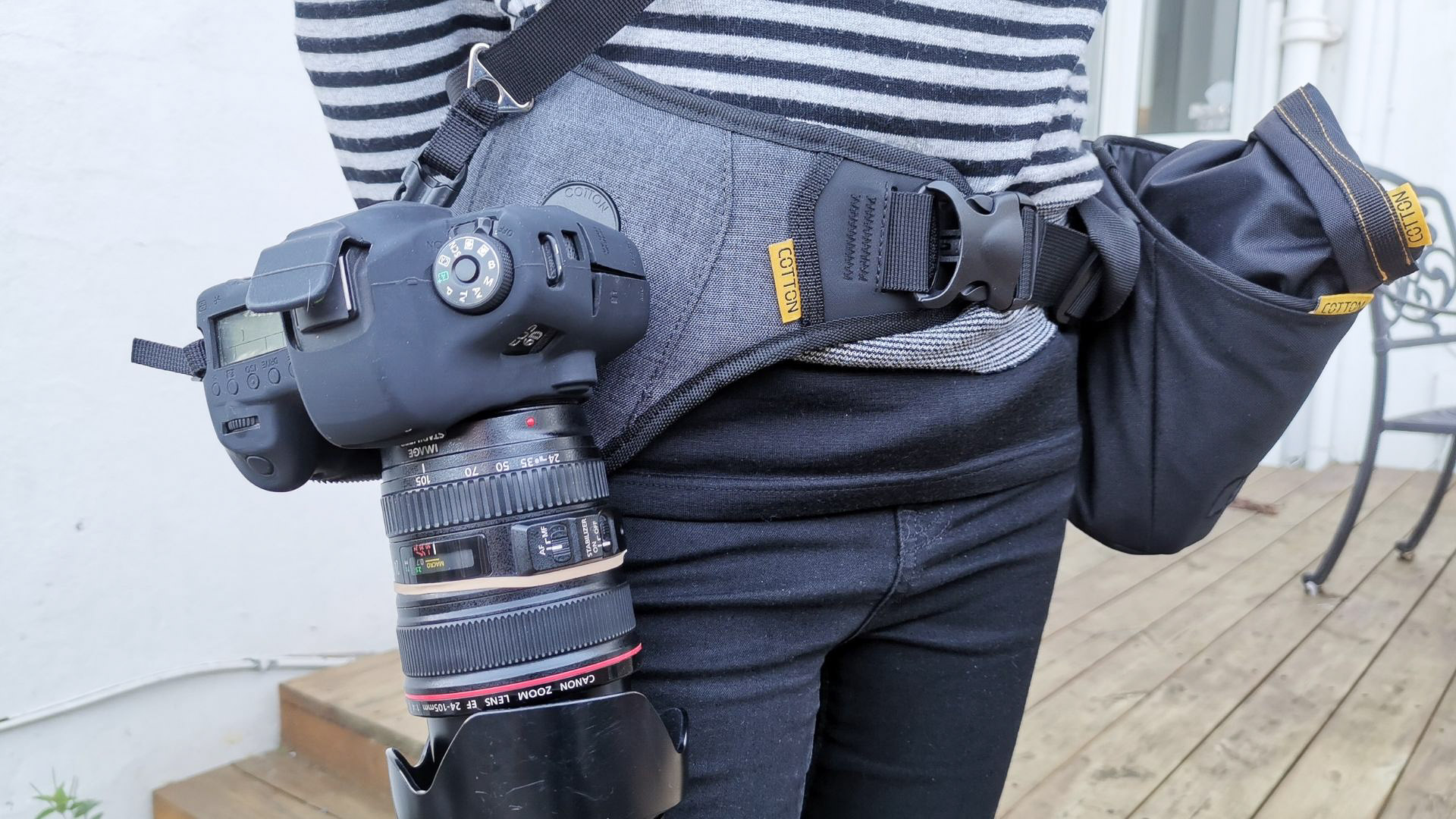
Specifications
Reasons to buy
Reasons to avoid
Rather than having your upper torso take the strain like most harnesses, the Cotton Carrier SlingBelt and Bucket system is a belt-based design that transfers the weight to your hips. At the core of the system is the Twist & Lock mount. Attaching the CCS mounting hub to a camera is a bit fiddly initially, but once set up, locking the camera into the belt receiver is quick and feels very secure. A simple twist and the camera is free, ready to shoot. It keeps the camera conveniently at your side, protected but instantly accessible.
The Lens Bucket accessory enables an extra lens (or even a water bottle) to be carried on the opposite side of the belt, adding to the system's modularity. The entire setup can be customized, depending on what is needed for the day. It is great to have a lens within easy reach without needing to rummage through a backpack.
Overall, I found the Cotton Carrier SlingBelt and Bucket to be a highly effective carrying solution, especially for photographers who prefer hip support or need quick access to their gear. While the initial hub attachment requires a little patience, the comfort, security, and modularity make it a strong contender if you're looking to ditch the traditional strap.
Read more: Cotton Carrier SlingBelt & Bucket System review
The best single-camera harness
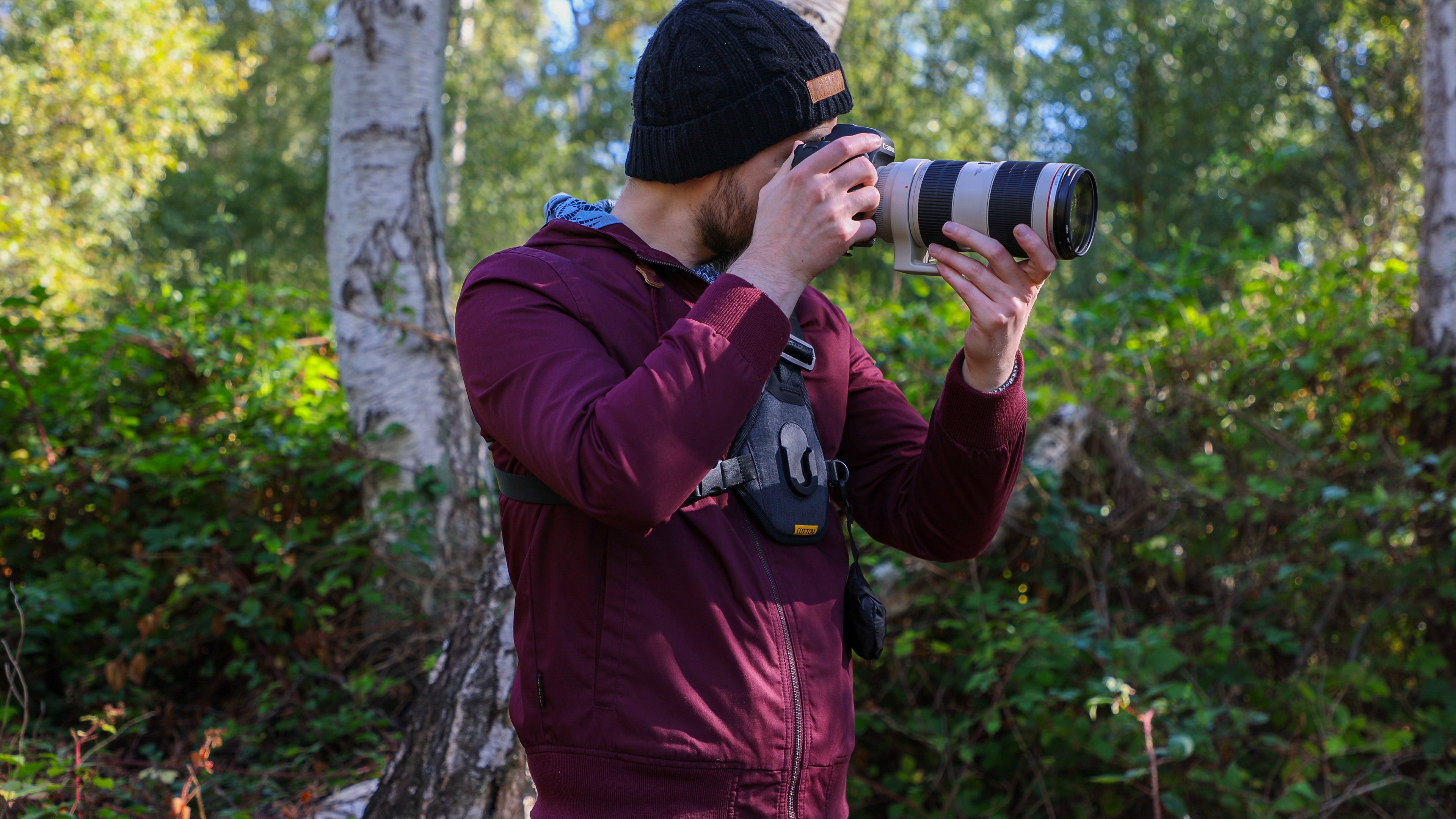
Specifications
Reasons to buy
Reasons to avoid
For a single-camera carrying solution that’s more comfortable and accessible than a traditional neck strap, but less cumbersome than a full harness, the Cotton Carrier Skout G2 is a sling-style harness that might just fit the bill. It's a well-made, durable product, crafted from sturdy synthetic materials. The ergonomic sling design distributes the weight of the camera across the shoulders and chest, rather than concentrating it all on the neck.
Setting it up with the Twist & Lock chest plate was fairly straightforward. I found that having my camera (fitted with a moderately sized lens) securely docked on my chest was fantastic for hands-free convenience. When I needed to shoot, a quick twist and the camera was free. The sling action allowed me to bring it up to eye level smoothly. It felt much more comfortable than having a camera bouncing around on a neck strap, especially during longer walks. The included rain cover and safety tether are also thoughtful additions, providing extra peace of mind.
However, rotating a larger, heavier lens in and out of the Twist & Lock mount feels a bit more cumbersome. I also found that without an additional security strap to stop lens movement, there could be some sway, and occasionally a bit of squeaking, which wouldn't be ideal for wildlife photography where silence is key. But overall, the Cotton Carrier Skout G2 is a great option for photographers using smaller to medium-sized lenses who want a comfortable, secure, and quick-access sling system, It’s particularly well-suited for activities like hiking, travel, or street photography.
Read more: Cotton Carrier Skout G2 review
How to choose the best camera harness
The best camera harness for you will depend on your priorities and budget. The first thing to consider is how many cameras you want to carry. Can you make do with just one body, or do you need to have two cameras with different lenses fitted?
The next consideration is the style of harness and size of your kit. If you only have a small camera and won't be wearing the harness for long periods, you might be able to get away with one of the cheaper harnesses. But these typically have no padding, and wearing them for a long period with a DSLR or a mirrorless camera fitted with a hefty lens would be torturous.
Finally, you may also want to consider looks. A rugged camera harness with lots of padding might be just the thing for landscape photography on a trek, but it might not be the best look if you're working a wedding or an awards ceremony.
How we tested the best camera harnesses
When testing camera harnesses, we pay attention to the quality of materials and build, comfort, and, crucially, how well the harness performs in practice, and what camera gear it is suitable for carrying. We use the harnesses in real-world situations, out on photo shoots, wearing them for an extended period to get a genuine impression of how comfortable and practical they are to use. For this guide, we have also compared specs, features, brand reliability, and value for money.
FAQs
What is a camera harness?
A camera harness is a type of strap that allows you to carry cameras hands-free while still keeping them easily accessible (i.e., not stowed away in a bag). They come in several different forms, with most camera harnesses spreading the weight of your gear across the torso and shoulders. This can make it more comfortable to carry a heavy camera for extended periods, whether you're hiking or working at a wedding, and it can also help to prevent neck and shoulder pain.
How does a camera harness work?
The basic concept behind most camera harnesses is that they sit over the torso to take a camera's weight, while a proprietary attachment fits to the camera's tripod screw and/or strap eyelets. Where they hold the camera varies, from the chest to the hips or hanging by your side. Some feature a clip-on, clip-off system, making them easy to mount while remaining secure.
What extra features come with the best camera harnesses?
Pricier camera harnesses often have extra features, as well as better materials and more comfortable designs. Some include a quick-release system, which allows the photographer to quickly remove the camera from the harness without having to unbuckle any straps. You might also get a safety tether: a secondary strap that connects the camera to the harness in case the main tether fails.
Look for lumbar support, which can help to reduce back pain, especially when carrying heavier cameras. Some harnesses also offer add-on holsters for additional cameras or lenses, while others are stuffed with pockets for storing accessories, such as memory cards or spare camera batteries.
The best camera deals, reviews, product advice, and unmissable photography news, direct to your inbox!

In addition to being a freelance photographer and filmmaker, Dan is a bona fide expert on all things Canon and Adobe. Not only is he an Adobe-certified Photoshop guru, he's spent over 10 years writing for specialist magazines including stints as the Deputy Editor for PhotoPlus: The Canon Magazine, Technical Editor for Practical Photography and Photoshop Editor on Digital Photo.
- Jamie CarterAstrophotography expert
- Adam WaringGuides Editor
